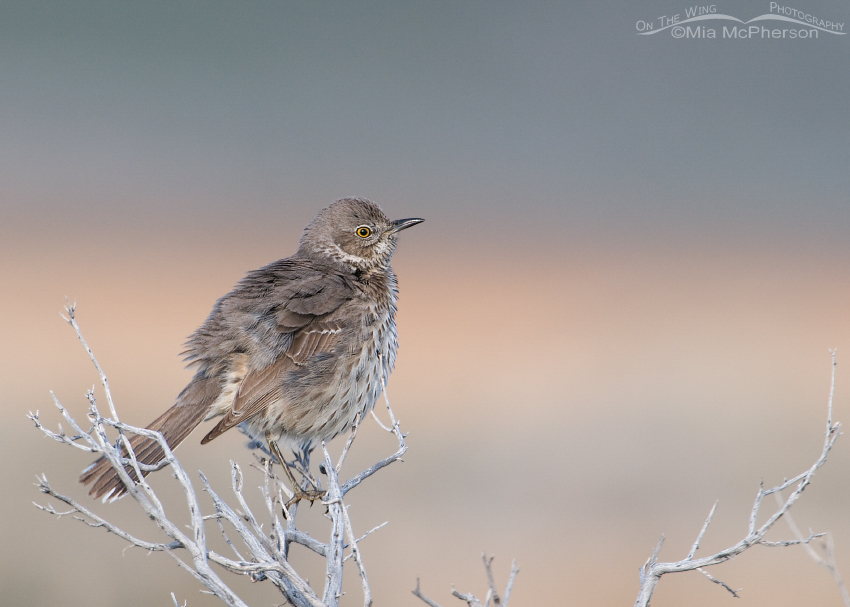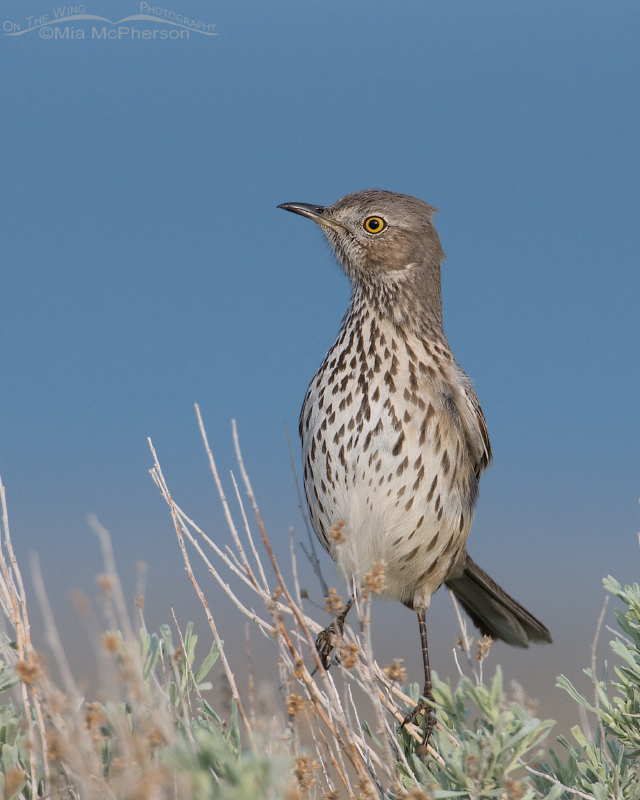 Fluffed up Sage Thrasher – Nikon D300, f7.1, 1/400, ISO 640, Nikkor 200-400mm VR with 1.4x TC at 400mm, natural light, not baited or called in
Fluffed up Sage Thrasher – Nikon D300, f7.1, 1/400, ISO 640, Nikkor 200-400mm VR with 1.4x TC at 400mm, natural light, not baited or called in
Sage Thrashers are considered sagebrush obligates meaning that they require sagebrush for some part of their life cycle and for the Sage Thrashers in Utah that means they need it during the breeding cycle. Antelope Island State Park has many large expanses of sagebrush steppe areas where the thrashers can breed. Sage Thrashers and Sagebrush just go hand in hand in my mind here in Utah.
 Very alert Sage Thrasher – Nikon D300, f7.1, 1/800, ISO 640, Nikkor 200-400mm VR with 1.4x TC at 400mm, natural light, not baited or called in
Very alert Sage Thrasher – Nikon D300, f7.1, 1/800, ISO 640, Nikkor 200-400mm VR with 1.4x TC at 400mm, natural light, not baited or called in
In some areas where Sage Thrashers have bred in the past their habitat has been destroyed by ranchers tearing out the sagebrush and converting those areas to open range land. Just recently I saw a large swath of land cleared for either cattle or horses in the foothills of the Stansbury Mountains where I have seen Sage Thrashers during their breeding season. Large scale removal of sagebrush on public and private land also has a detrimental effect on other sagebrush obligates which include 8 species of vertebrates.
I adore the spicy, pungent aroma of sagebrush and every time I see a photo of a Sage Thrasher I can almost smell it. I wish computers had the ability to emit aromas for those of you who have never had the opportunity to get a whiff of sagebrush. Some people hate it but I am in the love it camp.
Life is good.
Mia
Click here to see more of my Sage Thrasher photos plus facts and information about this species.


Wow, what I wouldn’t give to see this species, let along capture a photo like the ones you present here. Truly lovely. The vividness of the eye and detail of the spots just keep drawing me to that second shot. I can’t stop looking at it.
Love both images…Alas, I also love sage and am very saddened to learn that ranchers are destroying it for more graze…How very, very sad!!! Beef production is extremely costly, in so many ways (including our own health)isn’t it…
Especially love the second shot!
Mia, I love sagebrush and everything that gos with it! I probably have seen this bird but at the time did not know what it was. Wonderful captures here. How sad to hear of the “clear-cutting!”
Such a lovely bird and I’m glad they have a place to hang out in Utah. They are a migrating bird here so when I get to see them it’s always a treat.
It looks like two different species. Amazing the difference that being alert makes…
Great photos, thanks
I too love the smell of sagebrush, and I love these images. Brushing the snow off the patio furniture this morning, I heard a crow. Finally looked up to see a circling hawk being chased and harassed by a crow maybe 100-feet straight up. Must have a nest somewhere nearby.
Such beautiful, delicate color you’ve captured … and such wonderful detail, as always, Mia!!! A pleasure!!!
Fabulous shots of the Thrasher – That second one really pops.
Beautiful design on the Sage Thrashers, excellent photos.
Wonderful colouring in the photos, feels really relaxing for some reason? Farmers the world over (some not all) seem to place their business above local nature, and it is such a shame.